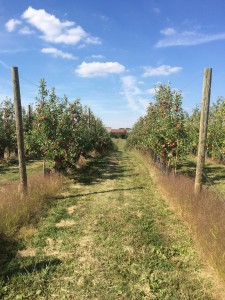So it’s (almost) that time of year again! If the Ithaca weather permits, fall is just around the corner and pretty soon, the apple cider will be hitting the dining halls again. I had the pleasure of taking a tour of the Cornell Orchards last Friday afternoon with some of the other Rose residents and had a great time learning more about the science of apple planting.

In between the rows of snap dragon apple trees.
During the course of the tour, I learned more about the system of growing an orchard. The Cornell Orchards uses a modern tall spindle growing system for a lot of their apples. The trees are planted three feet by twelve feet apart from each other in rows. Because of this, the trees will always stay relatively small in stature because of their competing root systems underneath the soil. New to my knowledge, apple trees can’t simply be grown by planting a seed; a limb of an already existing tree has to be spliced onto another tree in order to grow that fruit. Because of this, the apples don’t necessarily stay true to their type – breeding apples with this method always creates another cross breed. Our guide also showed us Cornell’s two newest breeds – the Snap Dragon and Ruby Frost apples, the former of which is very tart, but delicious, almost like a watermelon.
Our guide also gave us some insight into the apple cider making process. The Orchards uses a cold press to grind unbruised and fresh apples through the machine. The apples are made into an applesauce-like mash and eventually gets pasteurized and bottled before it’s sold. This season, it’s expected that the Orchards will make 1500 gallons of apple cider; get ready to see some cider in the dining halls in the next week or so!
